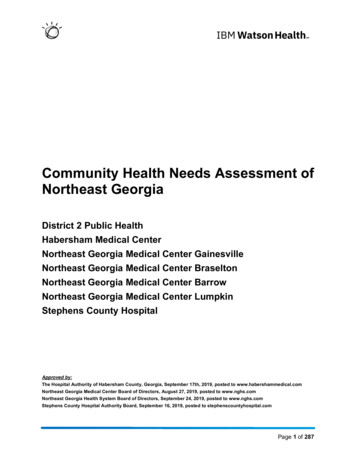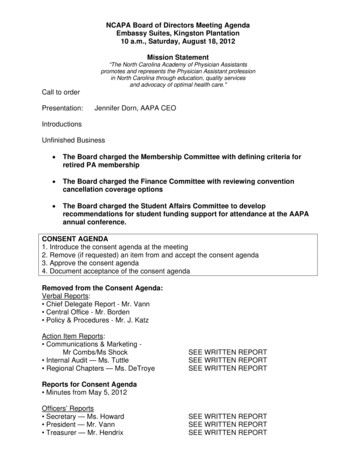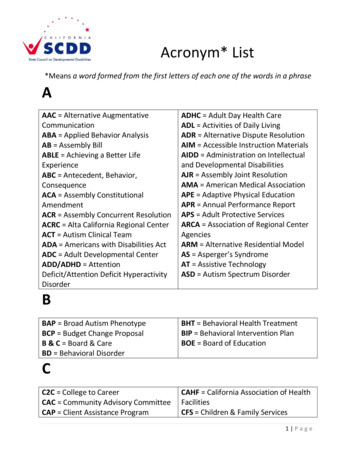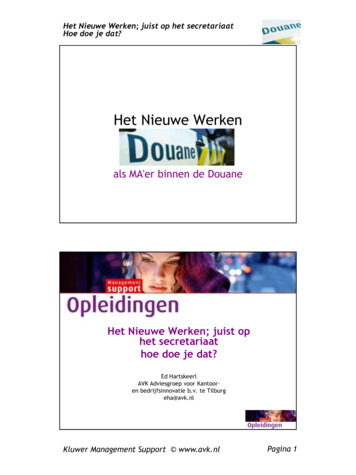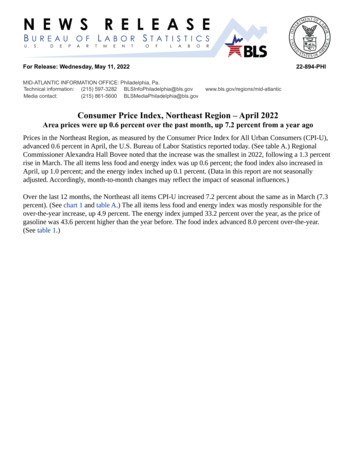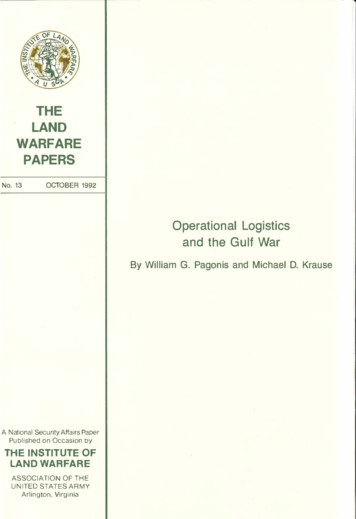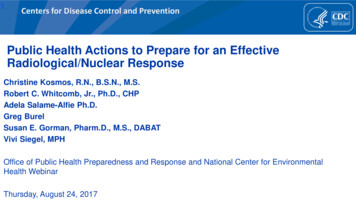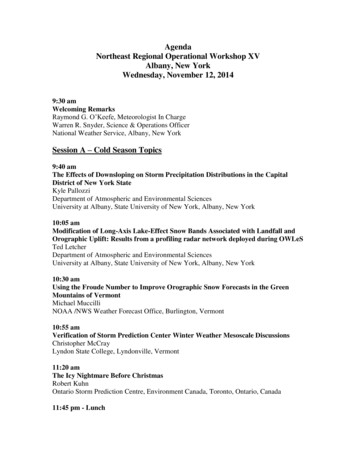
Transcription
AgendaNortheast Regional Operational Workshop XVAlbany, New YorkWednesday, November 12, 20149:30 amWelcoming RemarksRaymond G. O’Keefe, Meteorologist In ChargeWarren R. Snyder, Science & Operations OfficerNational Weather Service, Albany, New YorkSession A – Cold Season Topics9:40 amThe Effects of Downsloping on Storm Precipitation Distributions in the CapitalDistrict of New York StateKyle PallozziDepartment of Atmospheric and Environmental SciencesUniversity at Albany, State University of New York, Albany, New York10:05 amModification of Long-Axis Lake-Effect Snow Bands Associated with Landfall andOrographic Uplift: Results from a profiling radar network deployed during OWLeSTed LetcherDepartment of Atmospheric and Environmental SciencesUniversity at Albany, State University of New York, Albany, New York10:30 amUsing the Froude Number to Improve Orographic Snow Forecasts in the GreenMountains of VermontMichael MuccilliNOAA /NWS Weather Forecast Office, Burlington, Vermont10:55 amVerification of Storm Prediction Center Winter Weather Mesoscale DiscussionsChristopher McCrayLyndon State College, Lyndonville, Vermont11:20 amThe Icy Nightmare Before ChristmasRobert KuhnOntario Storm Prediction Centre, Environment Canada, Toronto, Ontario, Canada11:45 pm - Lunch
Session B – Modeling1:45 pmAn Alternative Gridded Verification Scheme: Zone-Based Snowfall VerificationJoseph P. VillaniNOAA/NWS/Weather Forecast Office, Albany, New York2:10 pmCSTAR Update: New Tools for More Efficient Use of Ensembles in OperationsBrian A. ColleSchool of Marine and Atmospheric Sciences, Stony Brook University, Stony Brook, NewYork2:35 pmEnabling Advanced Weather Modelling and Data Assimilation for UtilityDistribution OperationsAnthony P. PrainoIBM Thomas J. Watson Research Center, Yorktown Heights, New York3:00 pmObserved and Simulated Multi-bands in Northeast U.S. Winter StormsSara A. GanetisSchool of Marine and Atmospheric Sciences, Stony Brook University,Stony Brook, New York3:25 pmEvaluation of WRF PBL Schemes in the Marine Atmospheric Boundary Layer overCoastal Southern New England WatersMatthew J. SienkiewiczSchool of Marine and Atmospheric Sciences, Stony Brook University, Stony Brook, NewYork3:50 pm - Break4:15 pmUsing an Ensemble Kalman Filter to Explore Model Performance on Northeast U.SFire Weather Days (via GoTo Meeting)Michael EricksonSchool of Marine and Atmospheric Sciences, Stony Brook University, Stony Brook, NewYork
4:40 pmA Multiple Linear Regression Approach for Storm Surge Predictionsin the NY/NJ BightKeith J. RobertsSchool of Marine and Atmospheric Sciences, Stony Brook University, Stony Brook, NewYorkSession C – Blender Projects5:05 pmThe New England Blender ProjectPaul A. SissonNOAA/NWS, Weather Forecast Office, Burlington, Vermont5:30pmAn Overview of the National Blend of Global Models ProjectJeff S. WaldstreicherNOAA/NWS Eastern Region Headquarters, Bohemia, New York5:55 pm – Closing Comments, LogisticsWarren R. SnyderNOAA/NWS Weather Forecast Office, Albany , New York6:00pm - Adjourn
AgendaNortheast Regional Operational Workshop XVAlbany, New YorkThursday, November 13, 2014Session D – Warm Season Topics/ Convection8:30 amAn Examination of the 22 May 2014 Duanesburg, New York, Unexpected TornadicSupercellBrian TangDepartment of Atmospheric and Environmental SciencesUAlbany, State University of New York, Albany, New York8:55 amA Radar-Scale Analysis of Three Tornadic Thunderstorms in the Albany CountyWarning Area during 2014Brian J. FrugisNOAA/NWS Weather Forecast Office, Albany, New York9:20 amAn Assessment of Local Forecaster’s Ability to Anticipate Convective EventSeverity and Magnitude using the Hazardous Weather Outlook product at WFOBinghamton, New YorkMichael EvansNOAA/NWS Weather Forecast Office, Binghamton, New York9:45 amRadar Characteristics of the 13 August 2014 Portland, Maine Flash Flood EventJohn CannonNOAA/NWS Weather Forecast Office Gray, Maine10:10 am – Break10:35 amA Review of the Historic Long Island Flooding on 13 August 2014David StarkNOAA/NWS Weather Forecast Office, Upton, New York11:00 amUsing SPC Slight Risk Convective Outlooks to Identify Cases with Low PredictiveSkill over the NortheastMatthew VaughanDepartment of Atmospheric and Environmental SciencesUAlbany, State University of New York, Albany, New York
11:25 amA Case Study of the Revere, MA Tornado of July 28, 2014Matthew L. DoodyNOAA/NWS Weather Forecast Office, Taunton, Massachusetts11:50 pmWhat the Hail is Going On? A Comparison of 3 Recent Anomalously Large HailEvents that Impacted the Albany Forecast AreaThomas A. WasulaNOAA/NWS Weather Forecast Office, Albany, New York12:15 pm - LunchSession E – General Session2:15 pmProposed Changes in the Winter Weather Forecasts at the Weather PredictionCenter (WPC), and New Experimental ForecastsDan PetersenNOAA/NWS National Centers for Environmental PredictionWeather Prediction Center, College Park, Maryland2:40 pmForecasting Surface Wind Gusts in Positively Stable EnvironmentsBrian LaSorsaNOAA/NWS/National Weather Service, Weather Forecast Office, Sterling, Virginia3:05 pmThe New York State MesonetJ. BrotzgeAtmospheric Sciences Research Center, Albany, New York3:30 pmUsing Ensemble Models to Develop a Long-Range Forecast and Decision MakingToolBrandon HertellThe Consolidated Edison Company of New York, Inc. , New York, New York3:55 pm - Break4:15 pmImproving Decision Support Services for the Tri-State AreaNelson VazNOAA/NWS Weather Forecast Office, Upton, New York
4:40 pmUsing NOAA-Atlas 14 Return Periods to Aid in Flood ForecastingCharles RossNOAA/NWS Weather Forecast office, State College, Pennsylvania5:05 pmPatterns of Historic River Flood Events in the Mid-Atlantic RegionRichard H. GrummNOAA/NWS Weather Forecast Office, State College, Pennsylvania5:30 pmAn Overview of the Northeast River Forecast Center’s Use of Daily RainfallObservations from the Community Collaborative Rain, Hail & Snow Network(CoCoRaHS)Ronald HorwoodNOAA/NWS Northeast River Forecast Center, Taunton, Massachusetts5:55 pm - Wrap UpWarren R. Snyder6:10 pmAdjourn7:00 pmCSTAR Dinner at Buca di Beppo Italian Restaurant44 Wolf Road, Colonie, New YorkNROW XVI is scheduled November 4-5, 2015At the Nano South Conference Center, Room 103, 255 Fuller RoadOn the Campus of the College of Nanoscale Science and EngineeringState University of New York, Albany , New York
The Effects of Downsloping on Storm Precipitation Distributions in theCapital District of New York StateKyle Pallozzi1 , Lance Bosart1, Dr. Robert Gaza21Department of Earth and Environmental SciencesUAlbany, State University of New York, Albany, New York2New York State Department of Environmental Conservation, Albany, New YorkDownsloping is a process which has been observed to have a high impact on precipitationdistributions during many events in the Capital District of New York State. Forecastingthe magnitude and westerly extent of precipitation decreases due to downsloping in theHudson Valley is a major forecast challenge. This study seeks to address that issue bydetermining the best predictors for such events. Thus far individual 850 hPa and 925 hPawinds from soundings at Albany ( KALB) and storm mean 850 hPa and 925 hPa windvectors derived from NARR (North American Regional Reanalysis) data have beenexamined. Preliminary results from this study suggest that when winds have a strongeasterly component at 850 hPa and 925 hPa, lower precipitation values in the HudsonValley are most favored. A more surprising finding was the very small difference inprecipitation totals between the two easternmost locations in the study area (despite thelarge elevation difference). Future work will be done to examine other variables such assurface wind and surface geostrophic wind at Albany to assess their relationship todownsloping cases in the Hudson Valley.
Modification of Long-Axis Lake-Effect Snow Bands Associated withLandfall and Orographic Uplift: Results from a profiling radar networkdeployed during OWLeSTed Letcher1, Justin Minder1, Peter Veals2, Jim Steenburg2, Leah Campbell21Department of Earth and Environmental SciencesUAlbany, State University of New York, Albany, New York2University of Utah, Salt Lake City, UtahDuring the winter season, convective lake-effect snowstorms deposit large amounts ofsnow downwind of the Great Lakes. The Tug Hill Plateau is a 600 meter hightopographic feature on the eastern end of Lake Ontario, and is ideally located to receiveheavy lake-effect snow. A local climatological maximum ( 200” per year) of snowfalloccurs approximately 40-50km downwind of the lakeshore on the western slope of theTug Hill. The exact dynamical and microphysical mechanisms behind this maximum arenot well understood, due, in large part, to a lack of good observations.The Ontario Winter Lake-Effect Systems (OWLeS) field campaign ran during the winterof 2013/2014. During OWLeS, an east-to-west transect of four vertically pointing MicroRain Radars (MRR) was deployed to study the transition of lake-effect storms as theymove inland over the lakeshore and up the Tug Hill. The MRRs are profiling 24 GHzFM-CW-Doppler radars. All four MRR's were deployed in October 2013 and taken downin early 2014. During several events, the MIPs X-band Profiling Radar (XPR) was colocated with the MRR at Sandy Creek central school, providing additional data.The 2013/2014 winter was extremely generous in terms of lake-effect snow, providingample data for analysis. The MRR observations provide unprecedented insight into howthe vertical and temporal structures of lake-effect storms evolve as they move inland andinteract with the Tug Hill.A comparison between the MRRs across the transect shows that the echo tops remainroughly constant as the lake-effect convection moves up over the tug. In addition,convective updraft intensity decreases. This suggests that convective invigoration forcedby the terrain is not responsible for the snowfall enhancement on the tug. MRR datashow stronger reflectivity echoes and stronger updrafts nearer the shore, suggesting atransition from convective to stratiform precipitation as the band moves inland.Furthermore, the data reveal that low-level ( 1.5km AGL) microphysical processesincluding snow growth and sub-cloud sublimation significantly contribute to the inlandmaximum in lake-effect snowfall. The importance of these low-level processes reveals apossible limitation in quantitative precipitation estimates (QPE) from the local NEXRADradar.
These new results will aid weather forecasters by providing a better physicalunderstanding regarding the inland transition of lake-effect storms, and by serving as abasis for improving NEXRAD-based QPE for lake-effect systems.
Using the Froude Number to Improve Orographic Snow Forecasts inthe Green Mountains of VermontMichael MuccilliNOAA /NWS Weather Forecast Office, Burlington, VermontOrographic snow is a very challenging aspect of forecasting in the northeastern UnitedStates. This presentation provides a method for improving these forecasts using theFroude number. Past research has shown that variations in the non-dimensional Froudenumber during upslope snow events can be correlated to the nature of the orographicsnow bands and distribution of snowfall accumulations. Twenty-five observed northwestflow orographic snowfall cases from 2007 to 2012 in the Green Mountains of Vermontare examined. Composite synoptic analyses for all cases show 500-hPa northwest flowand cyclonic north to northwest flow at 850-hPa. Froude numbers were calculated foreach case which show that the Froude number has a critical level of 1.0, at which eventslower than this critical level become blocked and precipitation backs up into the lowerelevations of the western slopes of the Green Mountains. With Froude numbers less than0.5, snow affects the Champlain Valley and the Burlington metropolitan area. At Froudenumbers above 1.0, air flows more freely over the Green Mountain spine, and themajority of the precipitation falls along the mountains and downwind. Using the forecastFroude number, in addition to other fields from numerical weather prediction models, canassist forecasters in determining the potential for and resultant distribution of orographicsnow.Through the use of archived North American Model (NAM) and Rapid Update Cycle(RUC) forecast model soundings, archived individual and composite snowfallaccumulation reports and maps, and calculated Froude numbers, characteristics of theorographic snow bands will be discussed as well as how to anticipate their behavior andthe snowfall amounts and distributions they produce. This research has led to a Froudenumber forecast tool which has already been used successfully in the National WeatherService Burlington, VT Weather Forecast Office.
Verification of Storm Prediction Center Winter Weather MesoscaleDiscussionsChristopher McCray3,Christopher Melick , Israel Jirak1, Patrick Marsh1, Andrew Dean1, Ariel Cohen1, JaredGuyer11NOAA/NWS National Centers for Environmental Prediction, Storm Prediction Center,Norman Oklahoma2Cooperative Institute for Mesoscale Meteorological Studies, University of Oklahoma3Lyndon State College, Lyndonville, Vermont1,2The Storm Prediction Center (SPC) has issued winter weather mesoscale discussions(MDs) since 1997 to alert meteorologists at National Weather Service (NWS) WeatherForecast Offices (WFOs) and other partners of the near-term potential for heavy snowfallor freezing rain rates, winter mixed precipitation events, and for the initiation ofmesoscale blizzard conditions. To date, SPC has had no means of objectively verifyingthese discussions. An evaluation of mesoscale discussions from January 2007 to April2014 is performed to determine the spatial and temporal characteristics of the varioustypes of MDs issued. To aid in enhancing SPC winter weather operations, a verificationmethod is developed using gridded surface station precipitation type observations, localstorm reports (LSRs), and quantitative precipitation estimation (QPE) data. From thesurface observations and LSRs, a gridded dominant precipitation type product isgenerated and used alongside gauge-corrected National Mosaic & Multi-Sensor QPE(NMQ) and a snow-to-liquid ratio climatology to calculate estimated hourly snowfallaccumulations. Similar methods utilizing these datasets are developed for verifyingblizzard, freezing rain, and mixed precipitation MDs. A case study is performed for aheavy snow event over the upper Midwest, from which it is determined that a 40 kmneighborhood verification method, similar to that used in the verification of SPCconvective forecasts, best represents MD forecast accuracy. All datasets used areavailable in real-time, and products developed such as dominant precipitation type can beincorporated into operational systems for use in analysis and forecasting. The verificationsystem developed is also flexible, allowing for the implementation of new methods anddatasets as they become available.
The Icy Nightmare Before ChristmasSteve Knott and Robert KuhnOntario Storm Prediction Centre, Environment Canada, Toronto, Ontario, CanadaThis presentation summarizes a major ice storm that nailed Southern Ontario includingthe Greater Toronto Area during the period December 20 to 22, 2013. A brief overviewof the pre-storm set up and messaging will be given, followed by an examination of someof the numerical guidance and ongoing analyses that were used before and during thisclassical two part ice storm. This presentation will also show parts of new NinJoworkstation software that Environment Canada is using as part of the forecast productionprocess. Significant impacts across much of Southern Ontario will be illustrated,including direct effects on operations on the Ontario Storm Prediction Centre and manyof the Toronto area staff at Environment Canada. This ice storm will be clearlyremembered by many for years to come.
An Alternative Gridded Verification Scheme: Zone-Based SnowfallVerificationJoseph P. Villani, Vasil T. Koleci, Ian R. LeeNOAA/NWS/Weather Forecast Office, Albany, New YorkNational Weather Service (NWS) Weather Forecast Offices (WFO’s) verify snowfall forWinter Storm Warnings by computing the mean snowfall within each NWS forecastzone. To determine the mean snowfall within each zone, snowfall reports are addedtogether and divided by the number of reports. This method is antiquated, as it does notfactor in distance between points and is heavily weighted towards areas of greaterpopulation, where typically more snowfall observations exist. This method can beunrepresentative of outlying and higher terrain areas where snowfall can varysignificantly.A more modern snowfall verification method using Geographic Information Systems(GIS) has been developed at NWS Albany (ALY) using Geographic Information Systems(GIS) and an objective analysis technique.The verification is still performed bycalculating the zone-average snowfall, but utilizes GIS software for a more innovativeand scientific approach. Contoured snowfall maps are created using an inverse distanceweighted (IDW) interpolation scheme to obtain a graphical representation of observedsnowfall across a given area. Zonal statistics can then be calculated using the IDWsnowfall maps, resulting in a more representative mean snowfall for each forecast zone.The end result is a more precise verification. A method for generating forecast bias mapsfor snowfall using GIS is also presented, which compares forecast snowfall from theNWS Graphical Forecast Editor (GFE) with observed snowfall. Examples from the2013-2014 winter season are shown.
CSTAR Update: New Tools for More Efficient Use of Ensembles inOperationsBrian A. Colle, Edmund K.M. Chang, and Minghua ZhengSchool of Marine and Atmospheric Sciences, Stony Brook University, Stony Brook, NYStony Brook has been developing diagnostics and tools to help increase the use ofensembles in operations, especially in the medium range. Partners for this CSTAR projectinclude several NWS offices in Eastern and central Region, as well as several operationalcenters at National Centers for Environmental Prediction (the HydrometeorologicalPrediction Center, Environmental Prediction Center, Ocean Prediction Center, andAviation Weather Center), and the Developmental Testbed Center. At previous NROWmeetings, we highlighted an ensemble sensitivity tool, as well as a tool for Rossby Wavepacket (RWP) identification and tracking. To provide forecasters a better understandingof ensemble sensitivity signals as well as a connection with daily flow regimes, we haveselected 20 random potential storm cases in the day 6 NCEP CMC EC ensembleforecasts (90 members) to characterize the features of ensemble sensitivity signals underdifferent flow regimes. The 20 cases also include several false alarms (false cyclone orunderpredicted anticyclone) with no RWPs and no upstream blocking. When a coherentRWP exists, ensemble sensitivity signals tend to be much more robust and wellorganized. The largest values are either collocated with RWP or over the leading regionsof Rossby wave packet. When there is a stationary blocking system upstream, areas ofensemble sensitivity seldom extend upstream of the block, but they can be quite robustadjacent to blocking systems.One major challenge for forecasters is to quickly extract useful information from a largemulti-model ensemble. An efficient evaluation of ensemble models’ performance in highimpact weather events over the East Coast region is very important. We are developing anew ensemble clustering tool to help forecasters condense ensemble information, andevaluate ensemble models’ performance by separating the multi-model ensemble intodifferent scenarios and comparing them with the analysis. To start the iterative clusterprocedure, a predefined number of clusters or initial guess is randomly placed in the EOFPC1-PC2 phase space (using, for example, MSLP). Each ensemble member denoted bythe pair of PCs is then assigned to the nearest group center. New centers are computed byminimizing an objective function that represents the distance from each point to each newcluster center. Each point is examined again relative to the updated cluster centers. If nopoints can be reassigned because they are closer to another center, the iterations stop.Each member is assigned a weight value that identifies their relative strength ofmembership to their cluster. This talk will describe the fuzzy clustering procedure andapply it to a few cases, such as the 26-27 December Boxing Day blizzard using 91 multimodel ensemble members.
Enabling Advanced Weather Modelling and Data Assimilation forUtility Distribution OperationsA.P. Praino1, L. A. Treinish1, J. P. Cipriani1 , Richard Foltman2IBM T.J. Watson Research Center, Yorktown Heights, New York12DTE EnergyThe distribution system of an electric utility, particularly with an overhead infrastructure,can be highly sensitive to local weather conditions. Power outages caused by severeweather events can have major impacts on such operations. Hence, the ability to predictspecific events or combination of weather conditions that can disrupt that distributionnetwork with sufficient spatial and temporal precision, and lead time has the potential toenable proactive allocation and deployment of resources (people and equipment) tominimize time for restoration.To address these problems for a utility in southeastern Michigan, we are developing anapproach to couple weather forecasts to optimal crew deployment to enable positioningof appropriate restoration resources prior to an event. The first component of this coupledsystem builds upon the on-going work in applying mesoscale numerical weatherprediction (NWP) at the IBM Thomas J. Watson Research Center dubbed “DeepThunder”. It is derived from a configuration of the WRF-ARW (version 3.4.1)community model, and operates in a nested configuration focused on the utility's serviceterritory, with the highest resolution at one km, utilizing 42 vertical levels. Theconfiguration also includes parameterization and selection of physics options appropriatefor the range of geography within the domain from highly urbanized to rural. Thisincludes Thompson double-moment microphysics, Yonsei University non-local-Kscheme with explicit entrainment layer and parabolic K profile in the unstable mixedlayer for the planetary boundary layer, NOAH land-surface modelling with soiltemperature and moisture in four layers, fractional snow cover and frozen soil physics,Grell three-dimensional cumulus parameterization in the outer domain (nine kmresolution), and a three-category urban canopy model with surface effects for roofs,walls, and streets. It produces 72-hour forecasts, which are updated twice daily. Inaddition, it incorporates a diversity of input data sets ranging from NCEP RAP forbackground conditions, NCEP NAM for lateral boundaries, three-dimensional variationaldata assimilation from several thousand surface and near-surface observation stationsoperated by Earth Networks, NOAA and other agencies, and surface conditions derivedfrom remotely sensed observations provided by NASA and USGS. The surface data areparticularly important for stable and accurate boundary layer, land surface and urbancanopy modelling.Impacts on the utility operations from severe weather vary from convective, summerthunderstorms to winter wind and snow/ice events. Therefore, to converge on an optimalmodel configuration for consistent, year-around operations that are computationallytractable, retrospective analyses were conducted on ten events that occurred in 2012 and2013, which were representative of the weather events that led to disruption of the
overhead network. Numerical experiments as hindcasts were performed to evaluate themodel, whose results were compared to both conventional observations as well asreported utility outages. The validation methodology was developed focused on theutility's needs. It was built with the Model Evaluation Tools (MET version 4.0)community verification package. Temperature, wind, dew point and precipitation datafrom the aforementioned set of in situ surface observations were compared to the forecastdata as well as the data from the NOAA/NCEP North American Model.Although such NWP-based weather forecasts are only a prerequisite to the optimizationof weather-sensitive business operations, we will focus herein on the analysis of theweather component. A companion presentation will cover the impact (damage/outages)and restoration prediction effort. Hence, we will discuss the on-going work, the overallapproach to the problem, some specifics of the solution, and lessons that were learnedthrough the development and deployment. This will include a discussion of theretrospective analysis and the results of operational forecasting that began in July 2013.In addition to the evaluation, we will present how the forecasts are being used, includingthe deployment of customized visualizations. We will also discuss the overalleffectiveness of our particular approach for these and related applications, issues such ascalibration of data and quantifying uncertainty as well as recommendations for futurework.
Observed and Simulated Multi-bands in Northeast U.S. Winter StormsSARA A. GANETIS1, BRIAN A. COLLE1, SANDRA E. YUTER2, AND NICOLE CORBIN21School of Marine and Atmospheric Sciences, Stony Brook University,Stony Brook, New York2Department of Marine, Earth and Atmospheric Sciences, North Carolina StateUniversity, Raleigh, North CarolinaMesoscale precipitation structures within Northeast U.S. winter storms result inheterogeneous spatial and temporal snowfall throughout the region during any oneparticular storm. There have been many studies of single-banded snowbands in thecomma head, but fewer studies of multi-banded events. Multi-bands have been observedto be more transient and shorter-lived structures than single bands but are capable ofproducing similar snowfall rates and wind speeds. The goal of this study is to useobservational and model datasets to better understand multiband evolution in the contextof a large sample of snow events across southern New England. The precipitationstructures were subjectively classified into single bands, multi-bands, both single andmulti-bands, and non-banded using WSR-88D Doppler radar data that was stitchedtogether from Fort Dix, NJ (KDIX), Upton, NY (KOKX), to Boston, MA (KBOX) for 33storms from 1997-2014. The classification followed Novak et al. (2004; 2010) except thatmulti-bands are defined as 3 bands with a lifetime 2 h with similar structure andspatial orientation and movement. Out of the 33 total storms, 5 (15%) were classified assingle bands only, 5 (15%) as multi-bands only, 9 (27%) as both single and multi-bands,and 14 (42%) as non-banded. Results will also be shown highlighting the observedstability, moisture, and wind differences using soundings at OKX, Albany, NY (KALB)and Chatham, MA (CHH) as well as spatial composites using the NCEP North AmericanRegional Reanalysis (NARR) to compare with those of previous studies.The Northeast U.S. blizzard of 26-27 December 2010, also known as the “Boxing DayStorm,” was an exemplary case of multi-banding. The Weather Research and Forecasting(WRF) mesoscale model forced using 0.5 NCEP Global Forecast System (GFS) forinitial and boundary conditions was used to assess the predictability of multi-bandsduring this event down to 1.33-km horizontal grid spacing. Observations include the 88Dradars as well as a vertically-pointing Microwave Rain Radar (MRR) on top of the roof atStony Brook University. The typical 3-4 km grid spacing used in some operationalmodels is thought to not to be enough horizontal resolution to resolve multi-bands, andthe ability of 1.33-km grid spacing is discussed. There is also relatively large sensitivityfor the simulated multi-bands to varying the microphysical and boundary layerparameterization schemes within the model.
Evaluation of WRF PBL Schemes in the Marine Atmospheric BoundaryLayer over Coastal Southern New England WatersMATTHEW J. SIENKIEWICZ AND BRIAN A. COLLESchool of Marine and Atmospheric Sciences, Stony Brook University, Stony Brook, NYCoastal marine layer forecasts are important for the forecasting of severe storms andwind energy resources in the highly populated coastal marine environment of theNortheast U.S. (NEUS). Mesoscale models are known to have large biases in windspeeds, temperatures and moisture in the marine atmospheric boundary layer (MABL)over the NEUS coastal waters. The goal of this project is to evaluate the performance ofsix planetary boundary layer (PBL) schemes in the Weather Research and Forecasting(WRF-ARW) model version 3.4.1 in the coastal marine environment of the NEUS. Thisstudy region, stretching from the south shore of Long Island out to Cape Cod is an ideallocation for an offshore wind energy grid based on such factors as regional energydemand, water depth, and available wind resource.Verification of the six WRF PBL schemes (two non-local, first-order schemes and fourlocal, TKE-order schemes) was primarily done using a dataset of observations at multiplelevels from the Cape Wind tower in Nantucket Sound from 2003 to 2011, as well assurrounding NDBC and ASOS stations. A series of 30-hour WRF runs were conductedfor 90 randomly selected days between 2003 and 2011, with initial and boundaryconditions supplied by the North American Regional Reanalysis (NARR). All schemesgenerally displayed negative wind speed biases at the tower location, with larger biases inthe cool season than the warm season. Cool season winds were predominantly out of thewest-northwest and the schemes were typically too unstable in the lower MABL,resulting in weaker-than-observed wind shear and negative wind speed biases increasingin magnitude with height, suggesting too much mixing of weak
Radar Characteristics of the 13 August 2014 Portland, Maine Flash Flood Event . On the Campus of the College of Nanoscale Science and Engineering State University of New York, Albany , New York . The Ontario Winter Lake-Effect Systems (OWLeS) field campaign ran during the winter of 2013/2014. During OWLeS, an east-to-west transect of four .

